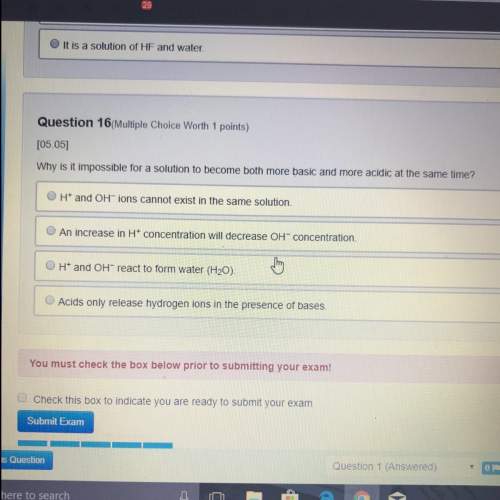1. The zigzag line on the periodic table divides

Chemistry, 27.10.2020 21:50 jpwalker9017
PLEASE
Choose the BEST answer.
1. The zigzag line on the periodic table divides
a. alkali metals and transition metals
c. semimetals and transition metals
b. metals and nonmetals
d. inert gases and halogens
2. The smallest particle into which an element can be divided and still be the same substance is a (n)
a. electron
b. proton
c. atom
d. molecule
3. Electrons are particles that
a. help make up the nucleus and have no charge
b. help make up the nucleus and are positively charged
c. are located outside of the nucleus and are negatively charged
d. are located outside of the nucleus and have no charge
4. If you found a Carbon 13 atom, you would know that
a. it has 13 protons
c. it has 13 neutrons
b. it has 13 electrons
d. it has 7 neutrons
5. What particles make up the nucleus?
a. electrons and neutrons
b. electrons and protons
c. protons and neutrons
d. electrons, protons, and neutrons
6. Neutrons are particles that
a. help make up the nucleus and have no charge
b. help make up the nucleus and are positively charged
c. are located outside of the nucleus and are negatively charged
d. are located outside of the nucleus and have no charge
7. The current model of the atom suggests that
a. proton clouds surround the nucleus
b. electron clouds surround the nucleus
c. electrons travel in definite paths around the nucleus
d. the exact path of a moving electron can be predicted
8. The mass number minus the atomic number is equal to the number of
a. protons and neutrons
b. protons
c. protons and electrons
d. neutrons
9. Mendeleev arranged the elements
a. density
b. melting point
c. how they look (appearance)
d. atomic mass
10. Which of the following is NOT found on the periodic table?
a. the atomic number of each element
b. the symbol of each element
c. the density of each element
d. the atomic mass of each element

Answers: 3


Another question on Chemistry

Chemistry, 22.06.2019 08:00
Identify a strong intermolecular force of attraction between an alcohol
Answers: 1

Chemistry, 22.06.2019 10:00
Part 1: include important facts found through your research. part 2: include your visual display. include your summary of “the chemistry of water” from the national science foundation website. include your experiment. part 3: include responses to the reflection questions.
Answers: 1

Chemistry, 22.06.2019 13:30
If the concentration of phosphate in the cytosol is 2.0 mm and the concentration of phosphate in the surrounding fluid is 0.1 mm, how could the cell increase the concentration of phosphate in the cytosol? a) passive transportb) diffusionc) active transportd) osmosise) facilitated diffusion
Answers: 3

Chemistry, 22.06.2019 17:10
In which block of the periodic table is uranium (u) found? s blockd blockp blockf block
Answers: 1
You know the right answer?
PLEASE
Choose the BEST answer.
1. The zigzag line on the periodic table divides
1. The zigzag line on the periodic table divides
Questions



Computers and Technology, 11.02.2020 18:56



Computers and Technology, 11.02.2020 18:56


Mathematics, 11.02.2020 18:56






English, 11.02.2020 18:56

Mathematics, 11.02.2020 18:56





Mathematics, 11.02.2020 18:57




